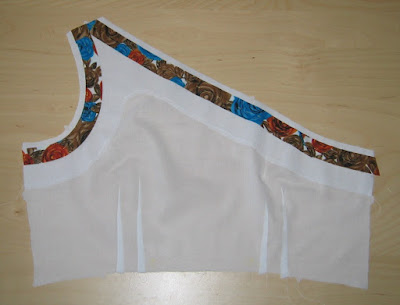 |
| So old, it qualifies for the Vintage Pledge! |
I know that I used it more recently than 1993, but sadly I also know that I'm (ahem) not exactly the shape I was then. I'm also a lot fussier about fit. In short, I needed a more recent pattern which I could use to work out fitting alterations. 2146 was already in my pattern stash, and an ideal shape.
 |
| 2011, so in the stash for a mere five years |
I made up the plainest version of the dress in my favourite toile fabric frost fleece, drew on the bust, waist and hip lines, and tried it on. As with Vogue and Style patterns, I need to shorten the bodice at both the waist and bust to get it to fit properly.
Once I'd got the fitting alterations sorted out, I could start on the actual pattern.
 |
| Circa 1943, according to the Simplicity website |
I must admit I'm a bit bemused by Simplicity's 'Retro' patterns. On the plus side, they've clearly gone to a lot of trouble with the envelope artwork. In most cases they've included photographs so that you get a better idea of what the finished dress will look like. Plus the photographs have been styled with at least a nod to period shoes and hair. And in a nice touch, either the artwork has been re-coloured to match the fabric or fabric has been specially printed to match the original illustration.
 |
| 1940s - much better length |
 |
| 1950s - not quite sure why this is 'Vintage' rather than 'Retro' |
 |
| 1960s - apart from the hairstyles |
I'm even prepared to forgive the fact that the dresses on 1777 are a bit short for the 1940s, especially the red one. I assume that this is to make it look more appealing to a modern audience, although I'm not sure why the same rule wasn't applied to 1587.
But. . . For a start, it really bugs me that unlike Vogue, Butterick and McCalls reissues, there is no date on the patterns, just a decade. Surely Simplicity must know the issue dates of their own patterns? Just labelling a pattern '1940s' is a bit vague. After all, both of these photographs are from the 1940s, but are very different looks.
 |
| Fashions from 1942 and 1947 |
On top of that, reading the instructions it's obvious that the dress is constructed using entirely modern techniques. Now I appreciate that I'm a sewing nerd, and that Simplicity are aiming to appeal to a broader market than just sewing nerds, but if on the vintage section of your website you claim that, "You can produce garments that look exactly as they would have done if they were made decades ago", then it would be nice for the instructions to include at least a few period methods as well as modern ones.
Anyway, rant over. I'm going to make a mix of the two styles shown, with the round neck and ¾ length sleeves. I've lengthened the skirt, and redrafted the pattern to fit me; hopefully I've got the proportions of the gathered bits right. So now I'm going to try making it up using techniques I've learned from some of my vintage patterns, for a truly 'retro' look. Details coming soon!


























